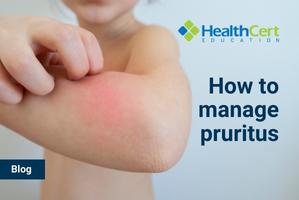How to manage keloids
Read more about how to manage keloids — including prevention, identification, first-line treatment options, and when to refer to a specialist.
-1.jpg)
HealthCert Education
Keloids are benign overgrowths of dense fibrous tissue that develop at the site of skin injury. They rarely regress and usually extend beyond the original wound boundaries (unlike hypertrophic scars). There are no medical indications for the treatment of keloids. However, these growths often cause discomfort, cosmetic concerns, and psychological distress. For most affected patients, GPs are the first point of contact. That is why GPs play a crucial role in the early management and referral of keloids.
How to identify keloids
Keloids typically present as shiny, raised, and firm skin nodules. They can be pink, red, or darker than the surrounding skin. Common sites include the chest, shoulders, earlobes, and upper back.
Important points to cover during the assessment are:
- History, including the onset, progression, previous injuries, family history (keloids can be hereditary), and associated symptoms like itching or pain.
- Physical examination to evaluate the size, location, color, and signs of secondary infection.
Differential diagnoses may include:
- Hypertrophic scars,
- Dermatofibromas, and
- Dermatologic malignancies.
Suspicious lesions (rapidly growing, ulcerated, or irregular) should be referred for dermatology evaluation or biopsy.
It is vital to educate patients about the chronic nature of keloids, treatment goals (control, not necessarily cure), and the risk of recurrence even after successful therapy. Individuals prone to keloids should avoid unnecessary skin trauma, including:
- Piercings,
- Tattoos, and
- Elective surgeries
First-line treatments for keloids
GPs can initiate first-line conservative treatments, such as:
Topical silicone gel/sheetsThese can help flatten and soften keloids, especially if started early, but daily, consistent use is crucial.
Pressure therapyFor keloids in accessible areas, such as earlobes, pressure earrings or garments may reduce growth.
Intralesional corticosteroidsTriamcinolone acetonide (10–40 mg/mL) can be injected directly into the keloid every four to six weeks. This is often effective in reducing inflammation and size. GPs trained in the technique can perform this or refer appropriately.
How to manage the symptoms of keloids
Some symptoms of keloids, such as irritation and pruritus, may be successfully controlled with topical corticosteroids, antihistamines, or emollients.
When to refer to a specialist
Referral to a dermatology specialist or a plastic surgeon is appropriate in the following situations:
- Large, painful, or functionally limiting keloids
- Failure of first-line therapies
- Diagnostic uncertainty
The advanced treatments that can be considered for keloid scars include:
- Laser therapy,
- Cryotherapy,
- Radiation, and
- Surgical excision (with adjunct therapy)
Prevention of keloids
The best prevention strategies for patients with a history of keloid formation include:
- Meticulous wound care after injuries or surgeries
- Use of silicone therapy during wound healing
- Early intervention at the first signs of abnormal scarring
GPs play an essential role in the early identification and management of keloids. With sufficient training in general dermatology, patient education, initial therapies, and timely referrals, GPs can significantly reduce patient distress and improve outcomes. However, individuals prone to keloid formation can achieve plenty by maintaining a proactive, preventive approach.
– Dr Rosmy De Barros
What's next?
For further information on this topic, you may be interested to learn more about the HealthCert Professional Diploma program in General Dermatology.
Or explore more research in primary care General Dermatology.
How to claim CPD hours:
 Engaging with this blog can help meet your annual Education Activities CPD requirement! If you consume educational webinars, podcasts, articles, or research on this blog, you can Quick Log CPD hours with the RACGP via the usual self-submission process. You will be asked to reflect on what you have learned, and you will require supporting evidence such as a screenshot.
Engaging with this blog can help meet your annual Education Activities CPD requirement! If you consume educational webinars, podcasts, articles, or research on this blog, you can Quick Log CPD hours with the RACGP via the usual self-submission process. You will be asked to reflect on what you have learned, and you will require supporting evidence such as a screenshot.
Download the RACGP’s guide to self-recording your CPD here.
References
Knowles, A., & Glass, D. A. (2023). Keloids and hypertrophic scars. Dermatologic Clinics, 41(3), 509-517.Ekstein, S. F., Wyles, S. P., Moran, S. L., & Meves, A. (2021). Keloids: a review of therapeutic management. International journal of dermatology, 60(6), 661-671.
Hawash, A. A., Ingrasci, G., Nouri, K., & Yosipovitch, G. (2021). Pruritus in Keloid Scars: Mechanisms and Treatments. Acta dermato-venereologica, 101(10), adv00582. https://doi.org/10.2340/00015555-3923
Fu, S., Duan, L., Zhong, Y., & Zeng, Y. (2024). Comparison of surgical excision followed by adjuvant radiotherapy and laser combined with steroids for the treatment of keloids: A systematic review and meta‐analysis. International Wound Journal, 21(3), e14449.

 1800 867 1390
1800 867 1390

-1.jpg)
-1.jpg)



